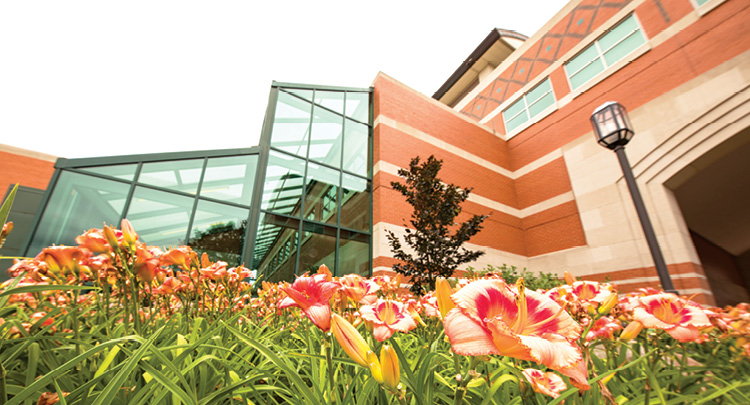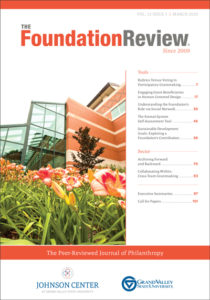Challenging Times Require Smart, Adaptive Philanthropy


 As I write this, I — like many of you — have been working from home for several weeks as COVID-19 continues to ravage the world, but glimmers of hope are appearing. We’re seeing infection and mortality rates slow down as physical distancing measures are having the intended results. (Keeping our distance from other people is now the best way we can show our love of humanity.)
As I write this, I — like many of you — have been working from home for several weeks as COVID-19 continues to ravage the world, but glimmers of hope are appearing. We’re seeing infection and mortality rates slow down as physical distancing measures are having the intended results. (Keeping our distance from other people is now the best way we can show our love of humanity.)
The philanthropic sector has stepped up to meeting the needs of individuals and communities as the twin health and economic crises continue. We’re seeing flexibility on the part of grantmakers in meeting the immediate needs of individuals, families, and organizations. Reporting requirements, funding restrictions, and streamlined proposal processes are being put in place. We’re seeing nonprofit organizations adapt and innovate quickly to meet the need for their services, finding no-contact ways to deliver meals and working to get technology in the hands of people who need to learn or get health care remotely.
Over the next year, as we move from crisis to recovery, we’ll need to continue to innovate. While the articles in the latest issue of The Foundation Review were written well before COVID-19 was part of our vocabulary, these authors share tools and frameworks that have great potential for supporting the work of foundations in this next phase.
Challenging times require smart, adaptive philanthropy, and the articles in Volume 12, Issue 1 — while not written to address the current situation — offer some timely suggestions for foundations seeking to respond effectively.
This article focuses on decision-making processes in participatory grantmaking efforts. Participatory grantmaking is a framework for engaging community members in determining what should be funded. As we recover, engaging communities in determining what they need will only become more important. The authors compare two methods for getting input, and found that neither approach overcame the bias toward larger organizations. They conclude that more consideration needs to be given to the criteria being used for selection, regardless of the method.
Here, Randell and MacDavey report on another tool for engaging community members. As part of ongoing efforts to engage grant partner voices in their work with young people who have intellectual disabilities, program staff at the Peter & Elizabeth Tower Foundation used human-centered design. This approach proved an effective team-building initiative with the potential to make grantmaking more participatory and to generate grantmaking opportunities that better incorporate beneficiary voice.
Especially during times of crisis, collaboration across parts of the sector is critical. The authors of this article used a social network analysis of community partners focused on addressing needs of people experiencing homelessness and housing shortages to illustrate how the results can constructively inform foundations on how they are viewed by community partners along dimensions of trust, value, resource contribution, activities, and contribution to outcomes. While this work was not done during the current crisis, social network analysis has potential to be useful as foundations assess their role with respect to other organizations in recovery efforts.
The disparate impact of the crises on communities of color has again highlighted the need for systems change to create more equitable communities. In this article, Takada, Nolan, and Mani describe the use of the Formal-System Self-Assessment Tool as a guide for focusing philanthropic efforts and creating greater understanding of their advancement.
The Sustainable Development Goals (SDGs) provide a framework for thinking about how private and public action work toward creating equitable communities. Here, the authors explore using the SDGs as a tool for communication; advocacy; linkages to common, worldwide efforts; and evaluating a foundation’s own choices (explicit or tacit). Compagnia di San Paolo, an Italian grantmaking foundation, assessed how successfully its work aligned with the SDGs. They found the foundation had made significant contributions to the goals in a number of areas funded by Compagnia. The analysis is particularly noteworthy in its identification of an unintentional pattern of convergence between the foundation’s activities and the SDGs.
Responses to the current crisis have been informed by what we know from previous disasters. Foundation archives can be an important resource for understanding how and why foundations take the actions they do. Eaton and Kowalewski describe how two different foundation approached preserving their records to support future research and analysis on limited-life foundations. Once they close their doors, much institutional knowledge is lost. The authors examine two specific cases — the Ralph C. Wilson, Jr. Foundation, which began planning for its archives early it its work, and the Atlantic Philanthropies, which began the process later. This article also offers recommendations for foundations seeking to plan and structure archives, with specific suggestions for organizing and preserving records at various stages of an organization’s lifespan.
Nonprofits often point out that while funders encourage them to collaborate, especially in challenging times, large foundations often fail to even collaborate across internal units. The authors of this article explore the challenges of internal, cross-team work. They conclude that as philanthropy seeks to support collaboration among grantees and launches new multifunder collaboratives to affect systems change, structures within foundations may need to change to actualize this ideal.